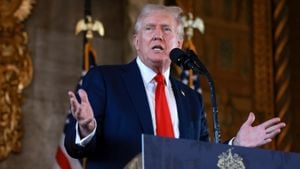After the death of Hassan Nasrallah, the once-influential leader of Hezbollah, the organization grapples with significant challenges as it faces leadership succession amid mounting tensions with Israel. Nasrallah, who transformed Hezbollah from a regional militia to one of the most formidable military forces backed by Iran, was killed on September 28, 2024, during Israeli airstrikes targeting his Beirut headquarters. This event marked the beginning of increased hostilities, thrusting Hezbollah's future and its operational integrity under scrutiny.
Nasrallah's death, which came on the anniversary of Egyptian president Gamal Abdel Nasser’s passing, was not only symbolically significant but also strategically pivotal, leading to statements from Israeli officials boasting about their assault capabilities. Following this, Israeli Prime Minister Binyamin Netanyahu described Nasrallah as “the terrorist” and emphasized his commitment to continue operations against Hezbollah.
Just days after Nasrallah's assassination, Israel confirmed the killing of Hashem Safieddine, widely considered Nasrallah's successor and head of Hezbollah’s executive council. Israeli airstrikes on October 3 targeted Dahiyeh, the same southern suburb of Beirut where Nasrallah had been eliminated. The loss of Safieddine, who was seen as the most likely candidate to lead Hezbollah post-Nasrallah, added another layer of tumult to the organization’s leadership structure.
Hezbollah mourned Safieddine's death, calling him “a great leader and martyr,” establishing him as another figure among those lost during the conflict. His passing triggered discussions about the remaining leadership pool within the group, with Naim Qassem, previously the deputy secretary-general, now stepping up as the most visible leader left to guide Hezbollah.
Qassem's initial speeches following his ascendance have showcased his intent to maintain continuity from Nasrallah’s era, even as he was described as lacking the strong charisma and popularity Nasrallah enjoyed. His attempts to connect with Hezbollah's base have been met with skepticism; many wonder if he possesses the necessary energy to galvanize the fighters during this tumultuous period.
Despite the upheaval within Hezbollah’s leadership, the group remains one of the best-armed organizations globally, with access to advanced military technology from Iran. Qassem vowed to continue the fight against Israel, echoing Nasrallah’s rhetoric of resistance, declaring before his followers, “The only place which the [drones] and missiles cannot reach...does not exist.”
Hezbollah has sustained substantial losses, with over 1,500 fighters reportedly killed since Israeli ground operations intensified following the escalation of hostilities on October 8, 2023. The conflict erupted after Hezbollah expressed solidarity with Hamas, launching rocket attacks across the border, leading to Israeli launches of what they termed “Operation Northern Arrows.” This operation involved extensive bombing campaigns aimed at degrading Hezbollah's military infrastructure.
The political and military maneuvers from both Israel and Hezbollah are tightly interwoven with broader regional dynamics. Israeli military leaders have openly stated their intention to eliminate the leadership of Hezbollah comprehensively, targeting not only current leaders but their successors. The IDF Chief of Staff, Lt. Gen. Herzi Halevi, maintains, “We will know how to reach anyone who threatens the security of Israel’s citizens.” This aggressive strategy has led to extensive casualties not just within Hezbollah, but also among civilians, with thousands reported displaced and fatalities increasing as airstrikes continue.
Internationally, the U.S. and Israel are maneuvering politically as well, hoping to leverage the current turmoil within Hezbollah’s leadership to strike deals favorable to their interests. U.S. Secretary of State Antony Blinken has urged Israeli leaders to pursue negotiations based on recent military successes against Hamas and Hezbollah, hoping to reach agreements featuring substantial commitments by both sides.
Yet, there remains significant hesitation from Hezbollah’s leadership to entertain any arrangements seen as capitulating to Israeli demands. Qassem made this abundantly clear during his speeches, framing the conflict not merely as retaliation but rather as a necessary defense against Israeli aggression, asserting, “Only one thing will end this war, which is the battlefield.” This highlights Hezbollah’s persistent commitment to military outreach rather than political negotiation.
Analysts suggest Hezbollah's leadership changes might have broader ramifications within Lebanon, where the population is caught amid the crossfire of these continued hostilities. Many Lebanese citizens are increasingly weary of the destruction brought on by the conflict, leading to internal pressures on Hezbollah to recalibrate its military objectives and strategies.
Qassem, on November 6, delivered his second speech as the new leader, stressing Hezbollah’s narrative of victimization by Israel, framing attacks as part of broader strategies of oppression against Lebanon and its people. His rhetoric tapped deeply rooted sentiments within the region concerning Israeli aggressions. He articulated, “The Israelis are engaged not just against us, but to rework the map of the entire Middle East,” showcasing Hezbollah’s perception of the conflict as one of existential importance.
This framing serves to galvanize support from Hezbollah's base, linking the current military engagement with longstanding narratives of resistance against external aggressors, reinforcing communal bonds even amid leadership changes. Such tactics are reminiscent of historical narratives employed by the organization under Nasrallah.
The future of Hezbollah now rests teetering on the precarious balance of Qassem's leadership capability and Israel's relentless pursuit to dismantle the organization's operations. With Safieddine’s death, Hezbollah is left with few leaders capable of matching Nasrallah’s legacy, leaving Israel with what they perceive as collapsed leadership ranks.
Despite this, analysts remain cautious about declaring Hezbollah incapacitated. The group maintains capable forces and substantial military resources poised to respond amid uncertain political conditions. Qassem’s leadership, albeit under intense scrutiny, still carries the weight of Hezbollah’s formidable military apparatus and its proven capacity to execute complex operations.
Above all, as prosperity remains illusive within Lebanon, both Hezbollah and Israel are compelled to reconsider their operational and strategic stances amid what increasingly appears to be more than just tactical skirmishes — these are battles deeply rooted within nationally adjacent threats, historical grievances, and international power plays. The dynamic between these two entities will critically define the forthcoming periods, both internally within their ranks and externally with the world stage watching closely.



